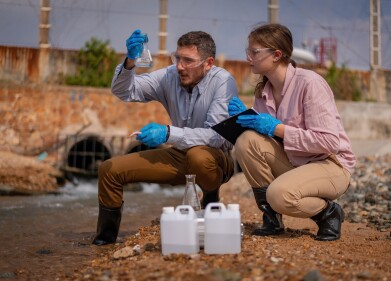Water/wastewater
New Sensor Accurately Measures Oxygen and Temperature in Demanding Applications.
Feb 20 2018
Endress+Hauser have released the Memosens COS81D hygienic optical sensor for measuring dissolved oxygen in fermenters and bioreactors used in the food, pharmaceutical and biotechnology industries, as well in drinking water and boiler feedwater applications. It can be used in all measuring points from lab fermenters to production processes.
The Memosens COS81D measures dissolved oxygen, gaseous oxygen and temperature with accuracy up to ±0.2%. It works in process temperatures from 15 to 280 °F and pressures from 0 to190 psi. The sensor also provides temperature and partial pressure, as well as raw measured values. The sensor connects to a transmitter via a cable that transmits an optical digital signal.
The sensor withstands CIP and SIP procedures, and resists halogen-containing solvents, ketones and toluene. The sensor is a compact stainless steel 12mm design with lengths currently up to 220 mm. The sensor has a low sampling volume, making it well suited for residual oxygen measurement in water treatment and boiler feedwater.
Two spot cap versions are available with the sensor: a C-shaped cap and a U-shaped cap. The first is particularly well suited to measurements in liquids, specifically in fermenters and bioreactors. The distinctive design of the U-shaped cap protects the spot from abrasion that can occur, for example, in gas measurements. The caps, specially designed for hygienic applications, reduce blockages and the adherence of air bubbles. Thanks to these caps, the sensor delivers extremely stable measured values across the entire measuring range. This stability is maintained even after dozens of CIP and SIP cycles.
The sensor can be replaced within seconds. The user simply calibrates the sensor in the lab, and then inserts it into the sensor holder assembly. It does not require any polarisation time and is immediately ready to measure. The sensor has integrated electronics that store calibration data and other information, such as total hours of operation and operating hours under extreme measuring conditions. Once the sensor has been connected, the sensor data is transferred automatically to the transmitter and used to calculate the current measured value. Because calibration data is stored in the sensor, the sensor can be calibrated and adjusted independent of the measuring point.
Measured and calibration values in the sensor are sent to the transmitter using a non-contact connection that is free from potential interference. Memosens technology in the transmitter generates an automatic error message if the sensor fails, or if the connection between sensor and transmitter is interrupted.
The optical signals are continuously monitored and analysed. The transmitter detects implausibly high or low measured values, irregular values due to incorrect measured values, and aging of the sensor cap. When errors are detected, the transmitter displays a warning and generates an error message.
Digital Edition
IET 35.2 March
April 2025
Air Monitoring - Probe Sampling in Hazardous Areas Under Extreme Conditions - New, Game-Changing Sensor for Methane Emissions - Blue Sky Thinking: a 50-year Retrospective on Technological Prog...
View all digital editions
Events
Apr 08 2025 Birmingham, UK
Apr 08 2025 Targi Kielce, Poland
Apr 08 2025 Baku, Azerbaijan
Apr 08 2025 Bahrain
Apr 10 2025 Beijing, China



















